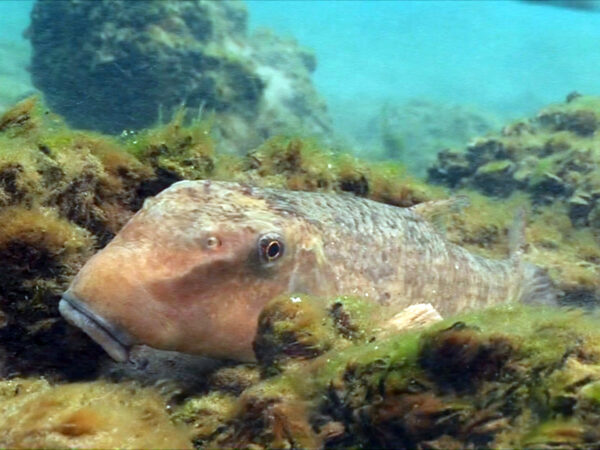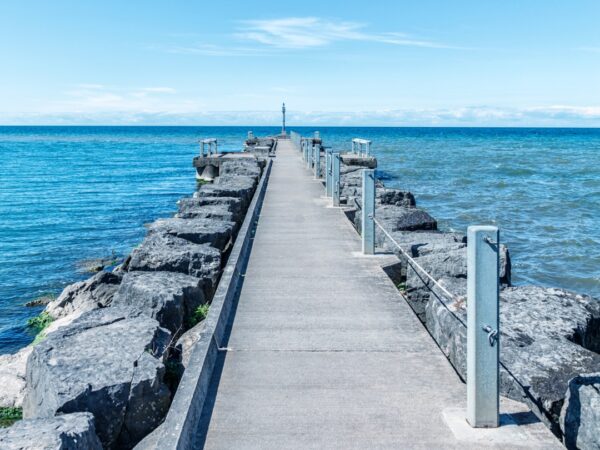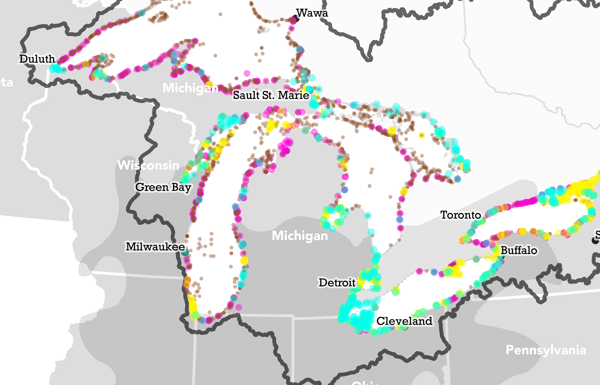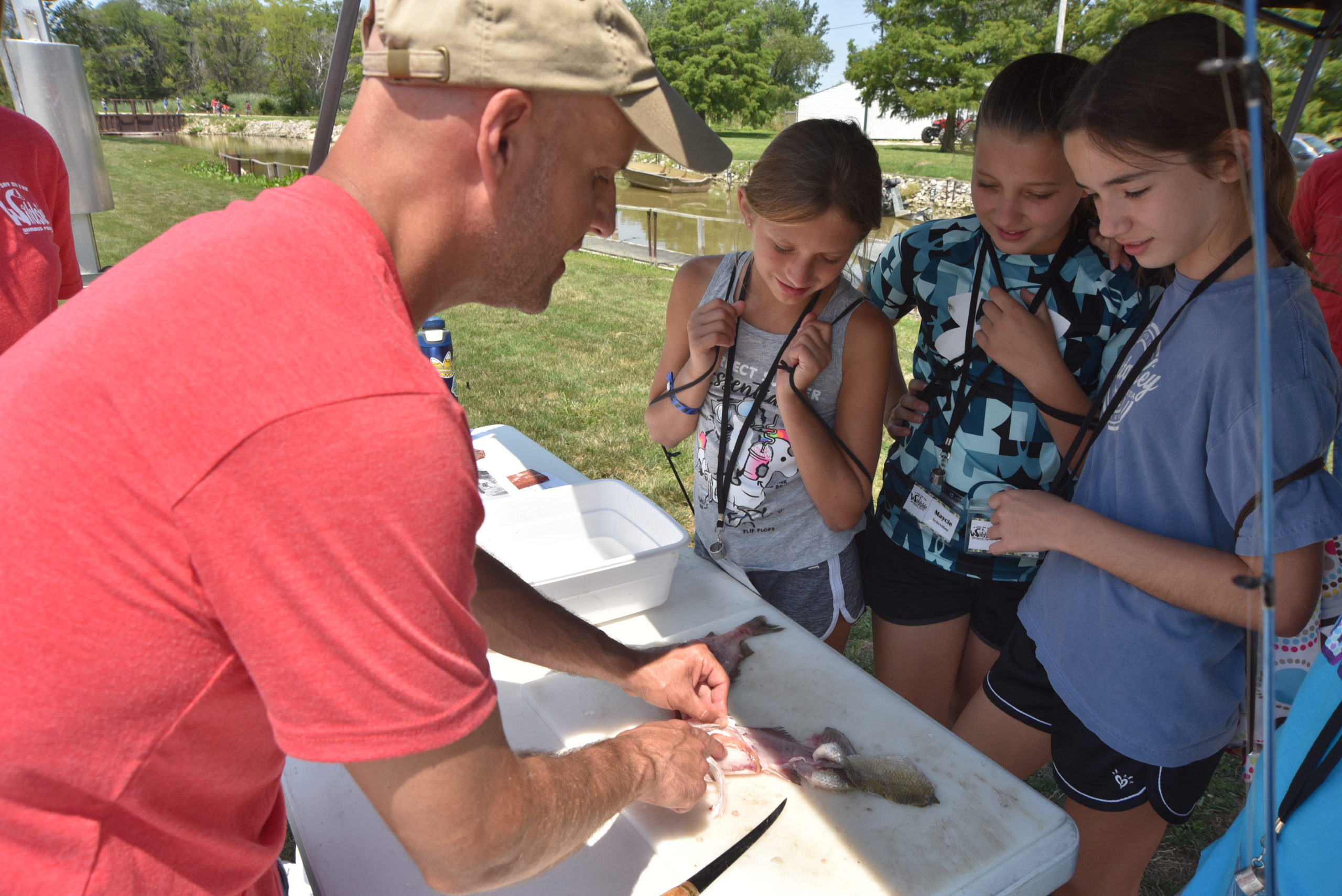
Tens of millions of fish from the Great Lakes are caught and kept every year by recreational anglers, and it’s common knowledge the vast majority of them meet the same culinary fate: filets coated in some type of breading or dipped in batter, and then fried in oil.
Walleye and yellow perch are the two species who suffer this fate the most.
But groups and individuals around the region have recently been working on projects aiming to encourage this culinary path and expand the scope of Great Lakes fish and wild game consumption.
At the 2021 Governor’s Fish Ohio Day in Port Clinton, Ohio Division of Wildlife Chief Kendra Wecker defended her department’s new mobile kitchen as employees worked diligently to keep a crowd of more than 100 supplied with a menu of cheddar grits, blackened walleye and fried walleye bites. She laughed when asked if she’s trying to put local food trucks out of business.
“You can’t stay in business if your prices are too low,” she quipped. “And our prices are free so we’re not actually in business.”
The division’s new mobile kitchen will travel the state offering up free fish and wild game treats in an effort to attract new participants to outdoor activities.
“One of our goals is meeting new people who maybe aren’t already hunters or anglers or trappers,” Wecker said. “We really want to hook them through their stomachs and taste buds.”
Wecker said the trailer, which features a complete kitchen set-up for on-site prep work and cooking, was planned pre-pandemic, though it just began its travels this year.
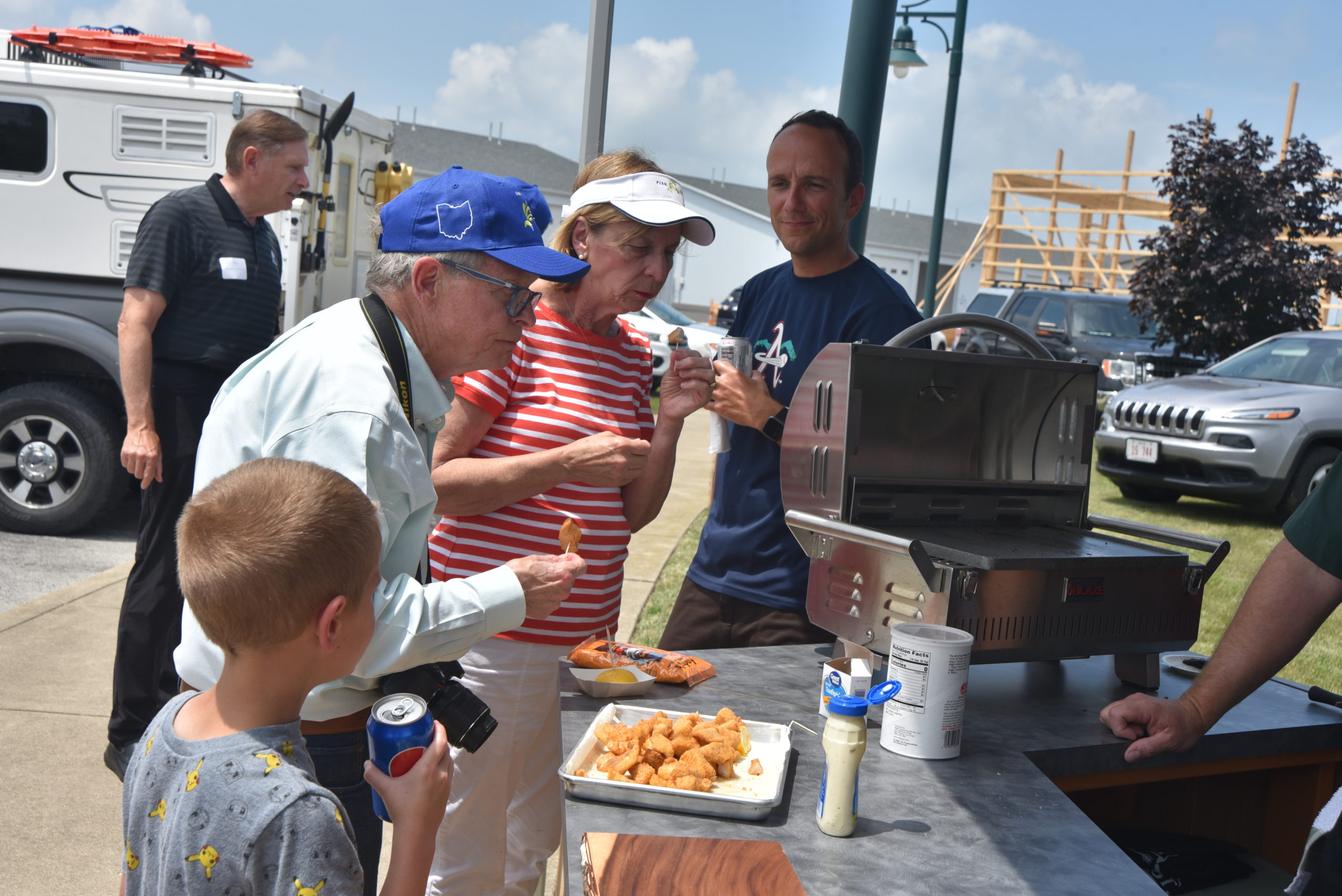
Ohio Gov. Mike DeWine and First Lady Fran get in on the walleye bites action. (Photo Credit: James Proffitt)
Local contributors, local targets
Matt Leibengood is ODW’s Lake Erie law enforcement supervisor and Ken Fry is one of their outdoors skills specialists, though on Fish Ohio Day at the Shores and Islands Visitor’s Center, they went by was Chef Leibengood and Chef Fry instead.
“Right now we’re looking at specific events, places with very specific target audiences,” Fry said. “One of the audiences we’ve identified as a good fit is the younger crowd who really appreciate finding food locally. They’re often called locovores. So we’ve taken it to farmer’s markets where we think maybe we can convince many that fishing and hunting are great ways to source their protein locally.”
According to Wecker, with hunting and trapping license sales on the decline in recent years, increasing numbers is crucial to funding Ohio’s wildlife management and habitat improvement programs.
Fry said he hosts cooking classes in addition to the sampling events and that it’s been well-received so far. It began with a pop-up tent and a pick-up truck at the Jefferson County fair in 2019. It was so well received, he said, that his supervisor told him to run with it.
“I’ve looked at local businesses, thinking about having their chefs come out and having cooking competitions, I think that would be a lot of fun,” Fry said.
Wecker said the ingredients for the operation come from a variety of sources, including evidence in wildlife criminal cases that have been closed and purchases from commercial operations.
“We have some leftover evidence, and also we’re using some from our sampling efforts too,” she said. “A lot of times we provide it to food banks, though whatever happens we never want to waste it.”
Ohio hunters, including DOW staff have donated deer, doves, waterfowl, squirrels and other wild game to the chefs.
After Fish Ohio Day, Ohio First Lady Fran DeWine became a fan of the kitchen and its dishes, so much so that she penned a column for the Xenia Daily Gazette and shared the blackened walleye and cheddar grits recipes she swiped from Leibengood and Fry.
More information about getting ahold of fish or wild game and how to cook it and store it can be found at Wild Ohio Harvest Community or the DOW’s official Youtube channel wildohioharvest cookbook.

Ohio Division of Wildlife staff serve up blackened walleye and walleye bites. (Photo Credit: James Proffitt)
Grant funds two-year aquaculture effort
A similar operation has popped up on the other side of the Great Lakes in Minnesota, though its online focus means its reach extends much further.
The Great Lakes Aquaculture Collaborative produces a series of cooking videos called Fish to Fork. The first episode features Rushing Waters Fisheries’ Peter Fritsch preparing and frying a whole rainbow trout. The second episode features staff from Wisconsin and Michigan Sea Grant cleaning whole fish, fileting fish, cleaning whole fresh shrimp and then grilling them.
“We also did a live online cooking contest during our last annual event,” said Amy Schrank, fisheries and aquaculture extension educator with Minnesota Sea Grant. “One of the things we’re finding in reaching out to our aquaculture partners is that people are a little bit unsure of how to cook seafood in general. So trying to educate consumers is a place where a need has been identified through our connections with producers. We’re trying to tell folks how to cook seafood in general, why it’s healthy and where it comes from.”
The Great Lakes Aquaculture Collaborative was created to develop and promote aquaculture in the Great Lakes region through a $1 million grant from the National Oceanic and Atmospheric Administration to the Sea Grant programs in all eight Great Lakes states. Fish to Fork is just one of the projects funded through this grant.
API key not valid. Please pass a valid API key.“The basic goal really is to create a region-wide connected and informed group, not only with Sea Grant folks but also with aquaculture farmers to create an industry that’s environmentally responsible, competitive and sustainable.” Schrank said.
She said people are often confused when they hear the term ‘aquaculture’ because they often think of pens along shorelines.
“When we say Great Lakes aquaculture, we’re not talking about aquaculture physically in the lakes,” Shrank explained. “We’re not talking about net-pen aquaculture like we think of in the oceans. This is all land-based aquaculture with a real focus on recirculating systems, so it’s like an indoor thing.”
In GLAC’s definition, aquaculture includes the production of fish, shrimp, baitfish, fish for stocking and ornamental fish.
She said aquaculture producers aren’t competing with commercial fishing operations or other fish that come from the lakes. In addition, sustainability is a key factor. One key difference is that aquaculture is not pulling fish out of wild populations.
GLAC’s objectives include identifying cutting-edge aquaculture knowledge, helping producers identify and complete research, and helping steer regulatory and policy changes favorable to the industry. The GLAC project summary also includes language which clearly establishes a goal of protecting water quality in the lakes and sportfishing operators.
Tory Gabriel, fisheries outreach coordinator with Ohio Sea Grant, recently spent a day at the Winous Point Shooting Club’s annual event, Day on the Wild Side. There he offered kids a quick education on cleaning fresh fish. As new groups cycled through his fish cleaning station every hour throughout the day, he pulled fresh fish from a cooler of ice and cleaned them, from beginning to end.
All the ‘Ooohs’ and ‘Aaahs’ were accompanied by keen observations and questions like “What is that?’ and ‘Can you eat that?’
“That’s what some people call walleye wings,” Gabriel said as he whittled away at a fish. “Just make a cut right there and right here, and you cut that off and it’s a big chunk of meat.”
That was followed by a brief discussion on omega-3 fatty acids (good) and lean meat (good) and heavy metals (bad), and then a tutorial on storing and freezing fresh fish.
Gabriel answered the barrage of questions from the kids then shared his recipe for homemade tartar sauce.
“Lots of onion, lots of pickle, fresh dill and mayonnaise – it’s a beautiful thing,” he said, smiling as he concluded his presentation.
Charter captain catches and cooks
Port Clinton charter captain Ross Robertson is a long-time Lake Erie walleye angler and is no stranger to creating videos and podcasts on fishing. Stories about his fishing exploits have been featured in numerous magazines and outlets. In a slight change of direction in 2019, he hired a professional videographer and began shooting cooking videos with long-time friend and angler Joe Gibson.
“We do fishing stuff with tips and tricks, yet I hear a lot of guys say, ‘Man, I fry fish, that’s what I do. I don’t want to waste my walleye on trying something new,’” he said. “So we’re kind of doing that for them.”
Robertson said his short videos are popular and he’s had people ask about being guests so they can share old family recipes. Recent videos include cold walleye salad, bacon wrapped walleye pinwheels, parmesan crusted walleye and walleye chowder.
API key not valid. Please pass a valid API key.Robertson said he just finished a video made with five anglers staying in a rented home in the Port Clinton area.
“They wanted something simple to do with their fish, something without a thousand ingredients and simple enough for guys that aren’t culinary experts and that’s got a little different twist,” he said. “A lot of them were really just substituting walleye for something else in a popular dish. One recipe everyone seems to love is walleye cakes. Hopefully through these videos it will give people the confidence to try this stuff on their own.”
Catch more news on Great Lakes Now:
Thousand Island Dressing Mystery: Uncertain origins of one of America’s favorite sauces
Fish, propane, cash: Not everyone loves Enbridge generosity in the Straits
Raising Fish: An inside look at how one hatchery is helping to restore native Great Lakes species
The Farmory: Is indoor fish farming a viable way of tackling declining fish populations?
Featured image: Ohio Sea Grant’s Tory Gabriel offers up a tutorial on how to clean, filet and store fresh-caught fish to kids participating in the 2021 Day on the Wild Side in Ottawa County. (Photo Credit: James Proffitt)
1 Comment
-
Yum! I might just have to make some sort of chowder coming up soon for my kid’s birthday game if only to dip some thick, warm bread into it.


